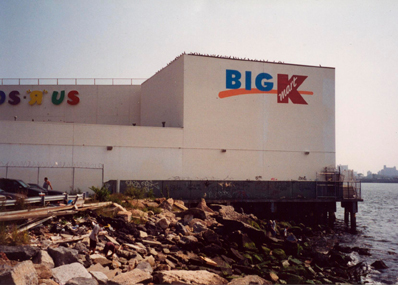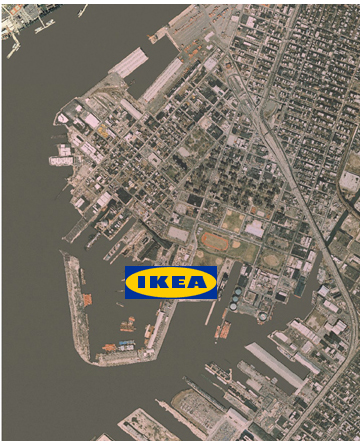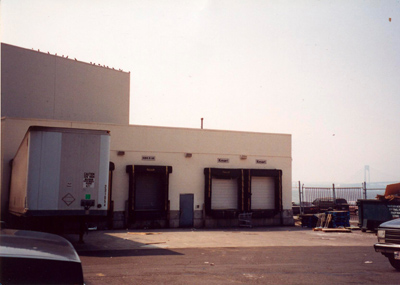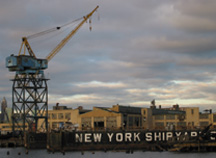9/11/01 - 02: An Unprecedented Attack On New York's Environment
One year after September 11th, experts believe that the collapse of the World Trade Center towers and the ensuing fires triggered one of the worst air pollution episodes in New York City's history.
Of course, the pollution-induced respiratory impacts from the trade center terrorism have been rightly overshadowed by the horrific toll of more than 2,800 lives that were lost as a direct result of the attacks. Moreover, the contaminants released from the World Trade Center's collapse and fires did not create a disaster comparable to the 1984 toxic gas leak at a Union Carbide plant in Bhopal, India, which killed over 3,000 and seriously injured 20,000 more. And significantly, outdoor air quality in Lower Manhattan has returned to pre-September 11th levels.
But the public health and environmental consequences from the September 11th attacks in New York have had disturbing short-term impacts for many thousands of New Yorkers. Concerns about indoor air pollutants remain among some who live and work in the area. And it is almost certain that a portion of those who have suffered sort-term health problems from inhaling pollutants on or after September 11th, or who were otherwise exposed to 9/11 contaminants, will experience mid-term or long-term respiratory conditions or disease.
The collapse of the two 110 story towers released an avalanche of debris and pollution that roared down adjacent streets in Lower Manhattan. Intense fires, fueled initially by thousands of gallons of jet fuel, sent billowing smoke over large areas of the financial district. Prevailing winds carried some of the pollution across the East River into Brooklyn. Huge volumes of pulverized cement, fiberglass and particulate matter of all sizes, along with hundreds of toxins (including asbestos, dioxins, and volatilized metals such as lead and mercury) were rocketed into the environment. The fires at Ground Zero, which continued for more than three months, emitted noxious gases; a sickening, acrid odor often pierced the air.
AT HIGHEST RISK
Public health risks from environmental assaults such as the one that began on September 11th are related directly to the intensity and duration of the pollution exposure.
Not surprisingly, then, the first short-term health impacts were seen am ong the first-responders, including thousands of hero firefighters who developed respiratory symptoms that were dubbed the "World Trade Center cough." Today, the New York City Fire Department reports, several hundred members are still suffering from significant respiratory problems. Indeed, some firefighters who came from across the country to assist in recovery efforts also returned to their homes with a variety of pulmonary and related symptoms.
Police, emergency personnel, construction workers and others who spent significant time at the pile are also among those who also may have received high exposures. More than one hundred ironworkers have been treated by occupational health physicians at Mt. Sinai's Selikoff Center for Occupational and Environmental Medicine. And according to the Center's Director, Dr. Stephen Levin, two of three still have persistent coughs and other signs of respiratory distress.
The several thousand largely untrained workers who were hired to clean out dust and pollution inside commercial buildings in the immediate vicinity of Ground Zero constitute another high risk group. A medicinal team headed by Dr. Steve Markowitz from the Center for Biology Systems at Queens College, supported by the September 11th Fund, set up a mobile van to provide free medicinal screening to such workers. In cooperation with the New York Committee for Occupational Safety and Health, the physicians saw 415 workers over a five week period. Almost all had persistent respiratory irritation and/or systemic symptoms such as headache, dizziness and poor appetite -- even though they had completed their work assignments four to six weeks prior to the medical examinations.
OTHER EXPOSED POPULATIONS
Another at risk group includes those office workers and others who were caught in the extraordinary cloud of pollution and debris on September 11th. Little information on the health impacts of this group has been developed to date.
Residents who returned several weeks later to their apartments faced lower risks than groups such as those mentioned above, most experts believe. Nevertheless, sensitive subpopulations, such as those with pre-existing lung diseases, are more likely to have suffered adverse respiratory reactions when they returned to their homes or offices. (And many of the returning residents have been understandably frustrated by the pace and scope of the long-delayed indoor clean-up program which is still -- one year later -- in the design stage.)
Lower Manhattan is also the home to a handful of public schools and other learning institutions, and some students also experienced short-term health problems in the aftermath of 9/11. At Stuyvesant High School, the first local school to reopen, some students (as well as faculty members and staff experienced a variety of adverse heath reactions, which were probably exacerbated by the debris-hauling barge operation that was located across from the school.
In total, approximately 10,000 to 30,000 people or more suffered some short-term respiratory problems associated with the terrorist attacks on the World Trade Center, according to a forthcoming report by the Natural Resources Defense Council (where I work). (This estimate is limited to pollution-related illnesses and does not include those who have experienced or may still be experiencing mental health problems in the aftermath of September 11th.)
There is much we still do not know about the environmental health consequ ences of the trade center's collapse and the subsequent fires. And the synergistic impacts of exposure to multiple pollutants makes the September 11th exposures extremely difficult to assess. For such reasons, it is essential that on-going health studies such as those underway at Columbia's Mailman School of Public Health (tracking pregnant women and their offspring), and at Mt. Sinai, New York University, Johns Hopkins medical schools be fully funded.
The September 11th attacks on the World Trade Center, in addition to their unspeakable loss of life and huge economic dislocations, also constituted an unprecedented attack on New York's environment. Thousands have suffered or are still suffering adverse health impacts. And much work still remains to be done to provide indoor clean-ups in residences and small businesses in the World Trade Center vicinity and to insure follow-up medical care to all those who were exposed.
But even as the recovery process continues, New Yorkers can once again stand outside in Lower Manhattan and breathe freely.
GOVERNMENT RESPONSE
How did government agencies perform in response to the environmental health challenges posed by the September 11th attacks?
What lessons can be learned from their actions?
And what steps should government take now to address remaining environmental health concerns and be better prepared to handle future environmental health emergencies in New York?
These questions will be addressed in Part II of this article, in October.
9/11 and the Environment: The Government Response
The September 11th attacks on the World Trade Center presented unprecedented challenges to our elected officials and their environmental and public health administrators.
As is now widely recognized, the response of Mayor Rudy Giuliani and other officials, their staffs and volunteers to the events of that day was, on the whole, magnificent and one for which New Yorkers remain proud and grateful.
Nevertheless, in the area of public health and environmental safety, shortcomings occurred in government's response to the World Trade Center attacks.
To be sure, in the hours and days after the collapse of the towers, the obvious priority were search and rescue operations. In addition, our nation was confronting not simply an environmental disaster but an act of war; there were numerous important concerns that demanded attention from government leaders. Moreover, the size and scope of the environmental and public health problems posed by the Trade Center's implosion and the ensuing fires, by themselves, consituted a unique set of challenges for understandably surprised agency leaders.
Despite such enormous difficulties, however, it must be acknowledged that public health and environmental officials made critical, though unintentional, mistakes in the days, weeks and months following September 11th.
BACKGROUND
As we reported in last month's Gotham Gazette "Environment" column, medical and environmental experts believe that the September 11th attacks triggered one of the worst air pollution episodes in New York City's history. An intense and dangerous cloud of pollution was produced from the avalanche of debris when the two 110-story office towers collapsed. Noxious fires, initially ignited by thousands of gallons of jet fuel, continued to burn at Ground Zero for more than three months. Tens of thousands of firefighters, other first-responders, fleeing office workers, building clean-up crews and downtown residents were among those who suffered adverse respiratory impacts. Independent medical specialists believe that at least a small portion of the thousands who experienced coughing symptoms, breathing difficulties, new-onset asthma and other respiratory and systemic conditions will suffer long-term health problems as a result of their exposures following September 11th.
Various city, state and federal environmental and public health agencies responded to the massive challenges posed by the September 11th attacks. While there is much that these departments and their dedicated staffs did to assist New Yorkers in need, at least five significant actions taken by top officials now appear to have been in error.
FIVE MISSTEPS
One of the first and most troubling missteps occurred in the first days after September 11th, when the nation was still reeling. On September 18th, U.S. Environmental Protection Agency Administrator Christine Todd Whitman issued an official statement in which she said: "I am glad to reassure the people of New York . . . that their air is safe to breathe and their water is safe to drink." Other statements from federal and city environmental and heath agencies couched their own statements during the month of September in similar terms, following the administrator's lead.
The desire to put the minds of New Yorkers at ease and get the city up-and-running was understandable. But such blanket statements over-simplified a complex situation in which different people faced different risks, depending on the intensity and duration of their exposure to Trade Center pollutants. And by serving to falsely reassure workers, for example, that the air was safe to breathe, such pronouncements probably decreased the number of rescue and recovery personnel who utilized appropriate respirators during their activities at Ground Zero. The reassurances may have also convinced some Lower Manhattan building owners, businesses and residents to delay professional clean-ups or to take fewer precautions when undertaking their own clean-up work.
A second shortcoming at the federal level involved the Occupational Safety and Health Administration ("OSHA"). That agency, which is responsible for insuring work safety at locations such as the Trade Center site, had agreed to forego its normal enforcement function and instead settle for an advisory role at the site. As a result of that agreement, OSHA was unable to enforce the basic safety requirement that workers confronting contaminated dust and toxic fires at Ground Zero be required to wear protective respirators.
Again, one can sympathize with the unusual situation that OSHA officials found themselves in and recognize their desire (which all New Yorkers shared) to do everything possible to help expedite the search for survivors. But even weeks and months after 9/11, when the prospects for rescue had diminished, OSHA's failure to insist upon respirator use by at-risk Ground Zero workers continued. As a result, at least hundreds of workers were confused about health risks and procedures, and were unnecessarily exposed to potentially dangerous air and dust.
A third error was New York City government's unwillingness to request as much help as was needed from the U.S. Environmental Protection Agency and federal health units such as the Centers for Disease Control. The U.S. EPA had available signficant expertise and a dedicated staff capable of assessing and addressing wide-ranging air quality issues. Nevertheless, the Giuliani Administration did not specifically request federal help on such issues as air pollution testing and clean-up in Lower Manhattan residences or in the neighborhood's public schools. Nor did top city officials reach out aggressively to secure federal medical assistance in assessing public health problems, such as the "World Trade Center cough," when these problems first emerged.
The Giuliani Administration's response -- assuming full command and seeking to control all phases of the September 11th rescue, recovery and restoration efforts -- served the city well in many areas. But in the case of the public health problems posed by the Trade Center-generated air quality problems, it meant that the city did not take advantage of federal experts and resources that were needed to supplement overburdened city environmental and health agencies. A major reason why the U.S. EPA did not get involved until the late spring in addressing indoor clean-up issues in Lower Manhattan, for example, was simply that the Giuliani Administration had failed to request such assistance.
A related shortcoming involved the city's decision to avoid a direct role in issues related to pollution clean-up and reoccupancy of residences and commerical establishments in the World Trade Center vicinity. The city's Department of Environmental Protection, under then Commissioner Joel Miele, essentially left to building landlords the task of insuring that dust and pollution were safely and completely removed from their buildings. The agency neither established specific clean-up tests and protocols, nor required building owners to submit proof that residences and common areas had been appropriately cleansed prior to reoccupancy. To make matters worse, the city's Health Department initially posted confusing and in some cases incorrect information for how residents should perform self clean-ups of their apartments.
As a result of such policies, unsupervised indoor clean-ups varied widely in quality and many Lower Manhattan residents remained perplexed for months about the safety of their apartments. To be sure, large commerical building owners were generally successful in providing their office tenants with space that had been thoroughly cleaned and tested for remaining contamination. But thousands of residents felt abandoned by the city, as they tangled with insurance companies and building owners while trying to become experts on such technical issues as asbestos and particulate matter measuring.
A fifth shortcoming in government's reaction to the unprecedented challenges posed by the September 11th attacks was an environmental health leadership gap. City, state and federal environmental and public health agencies met frequently at the staff level. But top officials failed collectively to designate a single person or agency to lead the overall environmental health response. No single spokesperson emerged to speak definitively to the public regarding respiratory problems, air quality levels or pollution clean-up issues. More than a dozen agencies were involved in addressing some aspect of these problems, but no single unit of government seemed to be in overall charge of these issues.
This led to long-lasting public uncertainly. It often seemed as if physicians in non-governmental institutions, such as the city's leading hospital facilities, were doing a better job at communicating risk and clean-up information than the numerous public officials who were ostensibly charged with performing such duties. This situation, combined with earlier governmental pronouncements that air quality posed no real problem, led many New Yorkers (including those experiencing respiratory symptoms) to mistrust the environmental health information that government was providing, even in situations where the government pronouncements were broadly shared by independent medical experts.
GOVERNMENT'S RESPONSE IN CONTEXT
These five missteps do not, of course, tell the whole story of the government's response.
For one thing, the problems stem from leadership decisions of top officials and do not for the most part reflect the performance of staff at the various governmental agencies. There are many examples of dedicated environmental and public health staff level employees who worked long hours to help alleviate the unprecedented environmental problems. Scores of EPA personnel, to cite just one example, set to work bringing in equipment from around the nation to clean contaminated debris from the streets, collect hazardous waste, test the air, and wash off workers who were leaving the Trade Center site.
In short, there were staff people at virtually every agency who worked in heroic fashion to help New Yorkers recover from this environmental attack.
We should also not forget the many elected officials who sounded the alarm about environmental health problems and who, led by Congressman Jerrold Nadler and Senator Hillary Rodham Clinton, did much to advance long-delayed remedial action.
New Yorkers and their elected officials must now reassess that response honestly and fairly, correct remaining difficulties, and revise their plans and practices to assure that New York City and the nation will be better prepared for any future environmental health emergency.
Big-Boxed In on the Waterfront

Just as the waterfront is coming into focus for many people, the vision of a Big Box store on the bank of Erie Basin in Red Hook, Brooklyn is evoking grave concern in one of New York's last maritime communities. A windswept swath of asphalt where a drydock should be, traffic clogging neighborhood streets, gigantic bags of dog food, cat litter, or laundry detergent blocking sight lines, the all-too-familiar chorus of car horns... Get ready, New York - IKEA is coming!
IKEA is the Swedish purveyor of contemporary classic furniture, like natural-finished wall units and kitchen tables, with huge stores mostly in the suburbs. The potential arrival of an IKEA on Erie Basin will change even more radically a rapidly-changing neighborhood that stretches between the blue-collar Gowanus Canal and the Pioneers of "Liberty Heights."

This will be only the latest Big Box store on the New York waterfront. Big Boxes started springing up nearly 30 years ago, with the opening of a new Macy's at the King's Plaza Shopping Center. Today you can find more than a dozen Big Boxes along the waterways, each instance of which poses challenges to neighborhood residents, city planners, and economic development agencies.
"The traffic in itself creates a whole host of other issues," said John McGettrick of the Red Hook Civic Association, pointing out that the site of the proposed IKEA is on New York State's Open Space Acquisition list. "With up to 10,000 vehicles per day we risk degradation of the quality of the park space by trying to stuff thousands of vehicles down this local street."
The concerns relating to the proposed IKEA are larger in scope than the length of the line of Volvo station wagons waiting to make the turn off Columbia Street. At issue in this now decades-old struggle is the fact that Big Boxes are not only anti-Mom-and-Pop, but that the sheer scale of these stores are wholly anti-urban.
To see this in reality one only need walk or bicycle along the Shore Parkway toward Coney Island, where the esplanade is swallowed up by a Toys R' Us parking lot. All of a sudden dramatic views of Lower New York Bay are subsumed by the vista of a loading dock.

The physical size of Big Boxes makes them an awkward fit in almost any urban site, much less a maritime hub such as Erie Basin. With this concern in mind, the Park Slope Civic Council has asked the Department of City Planning to "consider alternate sites for the IKEA store."
Perhaps the greatest concern with the Erie-Ikea proposal is that it plucks the tension wire between the seemingly immovable post of waterfront industrial neglect and the irresistible cannonball of gentrification.
Erie Basin is homeport to the Hughes Brothers Barge Basin, the largest concentration of hulking open-topped containers that carry bulk cargo like oil or gravel up and down the waterways, relieving city bridges and tunnels of millions of pounds of wear and tear each year. A new arrival in the Basin is New York Water Taxi's svelte yellow boats, who now call Red Hook their home port.

To some it's a deja-vu all over again. It was only two years ago that IKEA was seeking to build a new facility on the east side of the Gowanus Canal at the former US Postal Facility on 9th Street. That proposal died under the weight of traffic concerns and the same Mom-and-Pop defensive stance that has met similar proposals for 30 years
"It's tough," said one local economic development official, speaking anonymously since their organization has not yet reviewed the IKEA idea, "they are talking about a significant number of jobs - maybe 300-400. As much as 60 percent might be full-time, with good benefits including tuition assistance and dental. Half of our constituency is working people from Red Hook."

And the Big Box game goes on. No proposal has yet been filed with the Department of City Planning, who will have to decide whether to re-zone the parcel from heavy to light manufacturing to accommodate the Big Swedish Box. Councilmember Sara Gonzalez is brokering a meeting in the next couple of weeks to discuss IKEA and neighborhood concerns.
For now, you'd be better off just shopping by catalog.
Carter Craft, an urban planner, is program director of the Metropolitan Waterfront Alliance




